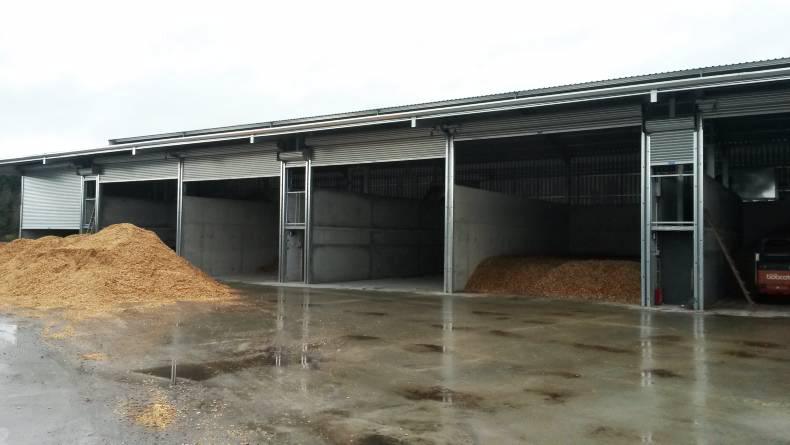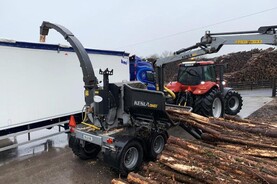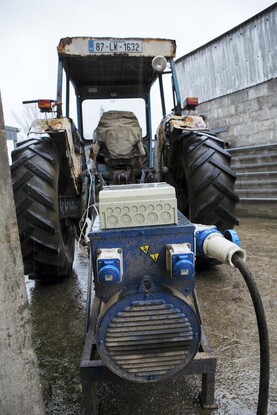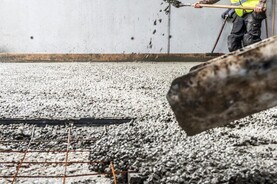Fred Maxwell has 270,000 broilers in 10 poultry houses near Augher in Co Tyrone and has recently constructed a woodchip drying shed to fuel biomass boilers to meet the heating requirements on his poultry unit.
Uptake of renewable technologies has been widespread by poultry farmers in Northern Ireland since 2012 when the Renewable Heat Incentive (RHI) was introduced by the government to help meet the target of 10% of heat produced from renewable sources in NI by 2020.
The non-domestic RHI provides financial support for renewable technologies by paying a tariff for every unit of heat energy produced from renewables in businesses.
Fred has heated his poultry houses with 10 99kWth biomass boilers with dry woodchip bought directly from suppliers for the past two years.
However, he decided to construct the drying shed and install three more boilers to heat the drying floor as undried woodchip is cheaper and in greater supply. He also has plans to buy unprocessed logs and chip the wood himself at times when it is economical to do so.
Pictures one and two
The drying shed began operating last week and has six separate drying bunkers. Two bunkers are served by one air tunnel in the middle as hot air is blown down the tunnel and up through the drying floor.
The drying floor was supplied and installed by Creagh Concrete, based in Toomebridge, Co Antrim, and can be used on farms for drying grain as well as woodchip and willow for biomass boilers. A lorry load of woodchip is emptied in front of the shed and a telehandler is used to push the chip into a bunker for drying. Chip is being stacked at a depth of 4ft in some bunkers and 8ft in others.
A bunker with 4ft of woodchip holds 27t at 50% moisture and is expected to take around two weeks to dry to around 20%, which is suitable for burning. The 8ft-deep bunkers hold 54t, which is expected to take four weeks to dry. The woodchip does not have to be moved around or shaken up during the drying process.
The walls of each drying bay are 4m high, meaning dried woodchip can be pushed back and stored higher, such as in the right-hand bunker in picture two.
Picture three
Dried chip is then put into a biomass bunker which feeds it into the boilers as required. A hydraulic roof on the bunker allows easy access for a telehandler to fill it with around 30t of dried chip (20% moisture) at a time.
As the system has only begun operating, Fred is unsure of the exact woodchip requirement on the unit, but estimates he will need 100-110t of wet woodchip drying each week for the poultry houses and the drying floor.
Fred has 13 relatively small boilers instead of fewer larger boilers as it was more economical due to the rates paid under the RHI. The tariff paid under the original RHI for boilers from 20 to 99kWth is 6.4p/kWh, whereas the next bracket for boilers from 100 to 999kWth in size is only 1.5p/kWh.
Each boiler heats water in a buffer tank to 80°C. Water is then pumped to the poultry houses where a radiator in fan heaters exchanges the heat from water to air and then fans blow the hot air throughout the houses.
Pictures four and five
Water from the buffer tank of the newly installed boilers goes back to the drying shed, where a radiator at the top of each air tunnel also exchanges the heat from the water to air and then a fan blows the hot air down into the tunnel.
The hot air coming from the fan creates a very strong draft throughout the tunnel. The walls of the air tunnel and each drying bay are made up of concrete wall panels that have a rubber seal at the joints, also supplied by Creagh Concrete.
Likewise, the air tunnel is well sealed around the door at the front of the shed to keep it airtight. When the fan is going there is strong force on the door which requires a heavy push to open to access the inside of the tunnel.
Picture six
The hot air is forced downwards and moves out of the air tunnel through the outlets at the bottom of the wall. A series of flaps over each section of the wall allow one bunker to be dried at a time from each air tunnel. The flaps are opened and closed manually, when open they are held up with a simple chain and hook.
Picture seven
Hot air moves under the drying floor through the outlets in the air tunnel. It then moves through the mesh on the drying floor and dries the woodchip above.
The floor is made up of individual concrete slabs with mesh that are 3m by 1.6m and approximately 215mm deep. The slabs are set on a solid concrete floor. However, on other sites the drying floor slabs have been raised up on dwarf walls. This means the drying floor is well-supported and can hold heavy machinery without causing any damage to the floor.
RHI changes
In November several changes to tariffs paid under RHI for new installations came into effect in NI involving introduction of tiered payments and an overall cap on tariffs.
The first tier of payments applies for the first 1,314 hours of heat produced each year, with a reduced tariff paid after this for tier two. An annual cap of 400,000 kWh applies to all biomass installations up to 199 kWth in size.
Revision of the three size ranges of biomass boilers for tariffs has seen the upper limit of the middle tariff increase from 99kWth to 199kWth in size. This could see less installations of several small boilers within the same business to avail of the higher tariff.






 This is a subscriber-only article
This is a subscriber-only article
















SHARING OPTIONS: